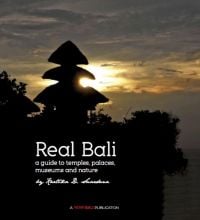Real Bali
- Title
- Real Bali
- Original language
- English
- Author(s)
- Illustrator(s)
- Publisher
- PT Phoenix Communications
- ISBN
- —
- Publication date
- 2014
- Subjects
- bali culture
- Find Book
- https://www.nowbali.co.id/4-books-about-bali/
- Related Env. Initiatives
- Related Places
- Related Biographies
- Related Children's Books
- Related Holidays
- Related Folktales
- Related Comics
- Related Lontar
- Linked words
Description(s)
Over the last thirty years, the tourism industry has blossomed and flourished in Bali, thriving on the natural beauty of the island, the astonishing rice terraces, the culture of dance, art and music, the processions, the temples and the ceremonies.But as tourism developed it began to push back the natural and cultural elements that it depended on, turning cow paths to crowded alleys, and deserted beaches to manicured resorts. The hotels that were built to bring tourists to the natural charms of Bali became magnets for spas, restaurants and shops in the surrounding areas and little by little, “real” Bali disappeared behind the concrete and steel of “new” Bali.Recently the pace has accelerated, with villas cementing over the fields, and malls blocking out the sunlight, until now Bali is sold worldwide more as a western-style park/club/dining/spa/shopping resort than a natural and cultural destination. We believe this is a great saddness and will not last long term, as the uniqueness of Bali is lost to the generic, non-Balinese development.Our response is this book, which is a guide to only the natural and cultural side of Bali : the temples, museums, natural attractions and 100% Balinese aspects of the island. Yes they still exist and indeed we only cover a small part of them, but need acknowledged, protected and preserved as the true source of tourism on the island. We hope this is the start of a return to “real”, authentic Bali in the eyes of the world.







Enable comment auto-refresher